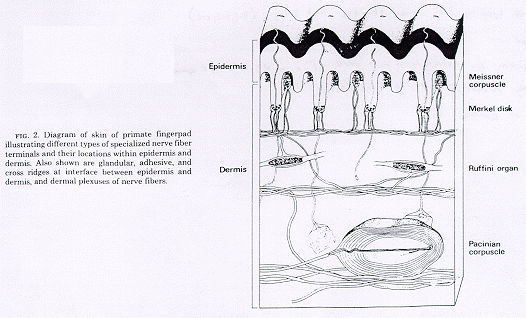
 |
|||||||
Tactile Neurophysiology |
|
 We have been collaborating with Dr. LaMotte of Yale University School of Medicine in conducting psychophysical and neurophysiological studies on the tactile perception of the microtexture, shape and softness of objects. We have shown that humans can detect extremly fine textures composed of 50 nanometers high parallel bars etched on plane glass plates (LaMotte and Srinivasan, 1991). Our neurophysiological recordings indicate that when such fine textures are stroked on the fingerpad skin, the fingerprint ridges vibrate and cause Pacinian Corpuscles to respond, thus enabling the detection of the microtexure (Srinivasan, Whitehouse and LaMotte, 1990). In studies of the tactile perception of shape, a series of two- and three-dimensional objects (e.g., cylinders, spheres, ellipsoids and wavy surfaces) were pressed or stroked at various orientations across the fingerpads of anesthetized monkeys and evoked responses in cutaneous mechanoreceptive primary afferent nerve fibers were recorded (Srinivasan and LaMotte, 1991; LaMotte and Srinivasan, 1993; LaMotte, Srinivasan, Lu, and Klusch-Petersen, 1994; LaMotte, Lu, and Srinivasan, 1995; 1996). Major geometrical properties of the shapes were well represented in the spatio-temporal responses of SA and RA afferent fiber populations, particularly those of the SAs. The results show that the following hypothesis explains qualitatively all the data we have obtained until now: the depth of indentation and the change in curvature of the skin surface are encoded by the discharge rates of SAs; in addition, the velocity and the rate of change in skin surface curvature are encoded by the discharge rates of both SAs and RAs. The intensive parameters of shapes, such as the magnitude of change in skin curvature produced by contact with the object surface were encoded in the discharge rates of SAs and RAs, but this neural code was also influenced by changes in stroke velocity. Spatial parameters of the response, such as the outline of the region of mechanoreceptor activity in the skin, encoded the size, shape and orientation of the 2-D outline of the object in contact with the skin. The third dimension of shape was represented best in the shape of the distribution of spatial discharge rates primarily in the SA fiber population. The shapes of the spatial discharge rates of RAs were more irregular and variable than those of SAs and exhibited poor or no representations of object shape. It was hypothesized that the distribution of slopes (in impulses/sec/mm) of the spatial discharge rate profile evoked by an object in the SA population encoded the distribution of curvatures on the surface of the object in contact with the skin. This is a neural code that is probably invariant with moderate changes in the parameters that govern contact conditions between the object and the skin, such as the contact force or orientation and velocity of its trajectory. Therefore, among the different possible geometric representations of the shape of objects, the intrinsic description, i.e., the surface curvature as a function of the distance along the surface, seems to be relevant for tactile sensing of shape. Based on a theoretical analysis of the mechanics of contact, we have proposed a mechanism by which shapes of objects within contact regions are perceived through the tactile sense. The curvature of the skin surface under an object, which we know from differential geometry is approximated by the second spatial derivative of surface deflection, is coded without differentiating (which is a noise enhancing process), but by exploiting its relationship to surface pressure. Pressure peaks occur where the depths of indentation and/or changes in the skin surface curvature are high. The skin effectively acts as a low-pass filter in transmitting the mechanical signals, and the mechanoreceptors respond to the blurred versions of the surface pressure distribution, thus encoding the shape of the object in terms of its surface curvatures (Srinivasan and LaMotte, 1991). We have also shown that the human discriminability of softness or compliance of objects depends on whether the object has a deformable or rigid surface (Srinivasan and LaMotte, 1995; 1996). When the surface is deformable, the spatial pressure distribution within the contact region is dependent on object compliance, and hence information from cutaneous mechanoreceptors is sufficient for discrimination of subtle differences in compliance. When the surface is rigid, kinesthetic information is necessary for discrimination, and the discriminability is much poorer than that for objects with deformable surfaces. The mechanistic data for rubber specimens indicates that the basis for the perception of softness of rubber-like objects is likely to be the spatio-temporal variation of pressure on the skin (or, equivalently the skin displacement and its derivatives). Neurophysiological data shows that the resulting responses from slowly adapting type I afferent population within the skin might encode the compliance of such objects. |
| Last Updated: May 8, 2002 1:45 PM | Comments: David Schloerb |